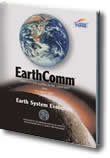This investigation will help you to:
- Pollen and Spores
- Paleoclimate
- The Response of Biomes to Climate Change
- To view information about pollen distribution from the Late Pleistocene to the present, visit the following web sites:
- To view information about distribution of animals from the Late Pleistocene to the present, visit the following web sites:
- To learn more about carbon-14 dating techniques, visit the following web sites:
- To learn more about late Pleistocene extinctions, visit the following web sites:
- Fossil Groups: Spores and Pollen, USGS
By analyzing pollen from well-dated sediment cores collected at critical sites, it is possible to obtain high-resolution records of vegetation change with decadal-scale resolution and to document community changes over the last few centuries and millennia. - List of Palynology Educators, University of Arizona
Find a scientist who studies pollen near you! Check out links to individual web sites organized by region.
- Weather, Climate, and Paleoclimate, NOAA Paleoclimatology Program
What is paleoclimatology? How do we measure paleoclimate? What can paleoclimatology tell us about climate change relevant to society in the future? Find out the answers to these interesting questions. - Paleoclimate, Goddard Institute for Space Studies, NASA
Learn about current research at the Goddard Institute for Space Studies that centers upon the use of global climate models (GCMs) to generate simulations of past climates.
- EPA Global Warming: State Impacts, Environmental Protection Agency
Find out how climate change will affect your state forests and ecosystems. Or learn about impacts in different regions:
To view information about pollen distribution from the Late Pleistocene to the present, visit the following web sites:
- Animated Maps of Vegetation Change, University of Oregon
The Quaternary Environments group at Brown in collaboration with Professor Patrick Bartlein of the Department of Geography at the University of Oregon have mapped the changing spatial distributions of pollen percentage for over 50 taxa from 21,000 calendar years ago to present. Maps of biomes derived from the pollen data and maps of multiple taxa were also include to show how the vegetation changed. *Unfortunately, there is a gap in the data available on this site that covers most of the western United States. - North America During the Last 150,000 Years, Oak Ridge National Laboratory Vegetation in North America has been continually changing over the last 150,000 years. This page provides brief descriptions and maps that detail these changes in smaller units of time.
*The graphics are a little fuzzy, but the text descriptions are very useful.
To view information about distribution of animals from the Late Pleistocene to the present, visit the following web sites:
- FAUNMAP: An electronic database documenting late Quaternary distributions of mammal species, Illinois State Museum
*The Faunmap site is currently under construction and the interactive capabilities are not working (as of 7/30/02). In the meantime, you can use a subset of the data to look at fauna found in the Los Angeles area from 40,000 years-present.
- Radiocarbon Dating, Radiocarbon WebInfo
The information on this page answers the following questions: How was radiocarbon dating developed? How does radiocarbon dating work? What kind of things can you date using radiocarbon? How did Libby test his method and find out if it worked correctly? How much sample material do you need to date using radiocarbon? How much does it cost to date using radiocarbon dating? What are the oldest things that can be radiocarbon dated? What is the youngest thing that can be radiocarbon dated? And more. - Radiometric Dating, Georgia Perimeter College
This discussion includes the principles of radiometric dating as well as explaining how Carbon-14 dating works.
- Late Pleistocene Extinctions, Illinois State Museum
This brief overview addresses whether human hunting or environmental changes were to blame for the Late Pleistocene extinctions. Plus it answers whether or not North American animals went extinct at this particular time in geologic history. - The Three Main Hypotheses, American Museum of Natural History
For two days in April 1997 three hundred scientists, journalists, policy makers and people like yourself gathered at the American Museum of Natural History to participate in the spring symposium titled "Humans and Other Catastrophes." Three main hypotheses surfaced as to the source of the extinctions at the end of the Pleistocene: Overkill, Disease, and Climate. Read about each theory and see which one you agree with.

